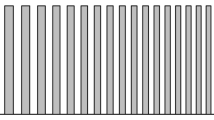Abstract
‘Probability dynamics’ (PD) is a second-order probabilistic theory in which probability distribution d X = (P(X 1), . . . , P(X m )) on partition U X m of sample space Ω is weighted by ‘credence’ (c) ranging from −∞ to +∞. c is the relative degree of certainty of d X in ‘α-evidence’ α X=[c; d X] on U X m . It is shown that higher-order probabilities cannot provide a theory of PD. PD applies to both subjectivist and frequentist theories. ‘Straight PD’ (SPD) produces associative and commutative mergers of evidence, in which evidences of positive credence are mutually reinforcing. ‘Offsetting PD’ (OPD) sets off conflicting evidences against each other. Subjectivist PD is a quantified second-order logic of action. Frequentist PD relates to descriptions of physical states of affairs. Acceptance of evidence α X1 = [c 1; d X1 ] at t 1 updates α X0 = [c 0; d X0 ] at t 0 into SPD-merger \(\alpha_0^{X}\oplus \alpha_1^X\) or OPD-merger \(\alpha_0^X\diamond \alpha_1^X\). Given ‘co-evidence’ \(E_0^{XY} = [c_0;P_0(XY),P_0(X\overline{Y}),P_0(\overline{X}Y),P_0(\overline{XY})]\) at t 0 < t 1, ‘indirect’ PD accepts evidence \(\widetilde{\alpha}_1^{Y} = [\widetilde{c}_1; \widetilde{d}_1^{Y}]\) at t 1 and produces support \(\hat{\alpha}_1^{X}\) for update α X10 = [c10;d X10 α X0 such that \(\alpha_{10}^X = \alpha_{0}^X\oplus \hat{\alpha}_{10}^X\) in SPD and \(\alpha_{10}^X= \alpha_{0}^X\diamond \hat{\alpha}_{10}^X\) in OPD. For binary X and Y, with α X0 = [c 0; P 0(X)] at t 0 (short-hand for \([c_0;P_0(X),P_0(\overline{X});X,\overline{X}]\)) and \(\widetilde{\alpha}_1^{Y}= [\widetilde {c}_1;\widetilde{P}_1(Y)]\) the accepted evidence, the support is \(\hat{\alpha}_1^{X}=[\hat{c}_1; \widetilde{P}_1(Y)P_0(X|Y)+\widetilde{P}_1(\overline{Y})P_0(X|\overline{Y})]\); \(\hat{c}_1=|\rho_0(X, Y)|c_0\widetilde{c}_1/[c_0+(1-|\rho_0(X, Y)|)\widetilde{c}_1]\); where ρ0(X, Y) is the correlation coefficient of X and Y, and update α X10 of α X0 is \(P_{10}(X)=[c_0P_0(X)+\hat{c}_1\hat{P}_1(X)]/ (c_0+\hat{c}_1); \quad c_{10} = \lambda(c_0+\hat{c}_1)\) with ‘accord’ λ = 1 in SPD and \( \lambda=1-2|P_0(X)-\hat{P}_1(X)|\sqrt{c_0\hat{c}_1}/(c_0 + \hat{c}_1)\) in OPD.
As \(\hat{c}_1/c_0\to \infty\), \(\tilde{P}_1(Y)\) tends toward update P 1(Y) of P 0(Y), but P 10(X) does not converge toward ‘ \(P_1(Y)P_0(X|Y)+P_1(\overline{Y})P_0(X|\overline{Y})\)’ of ‘probability kinematics’. Therefore PD is not compatible with probability kinematics. A process of ‘normalization’ interprets ‘β-evidence’ [[c 1; q 1]& . . . &[c m ; q m ]; U Xm ]] with [c j ; q j ] on \(\{X_j, \overline{X}_j\}\) and m ≥ 3, as an α-evidence on {X 1, . . . , X m }. It is shown that SPD- and OPD-updates can be derived from updated cumulative functions. Time-biased updates are discussed. A PD-based theory of confirmation (PDCT) is presented
Similar content being viewed by others
References
T. Bayes (1764) ArticleTitle‘An Essay Towards Solving a Problem in the Doctrine of Chances’ Philosophical Transaction of the Royal Society of London 53 370–418
D. Christensen (1999) ArticleTitle‘Measuring Confirmation’ The Journal of Philosophy 9 437–461 Occurrence Handle10.2307/2564707
B. Finetti Particlede (1970) Theory of Probability NumberInSeriesVol 1 John Wiley London
B. Finetti Particlede (1972) Probability, Induction and Statistics John Wiley London
J. Earman (1992) Bayes or Bust? A Critical Examination of Bayesian Confirmation Theory The MIT Press Cambridge Mass
F. Feller (1957) An Introduction to Probability Theory and Its Applications EditionNumber2 NumberInSeriesVol 1 John Wiley New York 221–222
Gaifman, H.: 1985, ‘A Theory of Higher Order Probabilities’, In Proc. l986 Monterey Conf. Theoretical Aspects of Reasoning about Knowledge, Morgan Kaufmann, Los Altos CA, pp. 275–292.
C. Glymour (1980) Theory and Evidence Princeton University Press Princeton, N.J.
B.V. Gnedenko (1989) The Theory of Probability EditionNumber5 Chelsea Publishing Co. New York
I.R. Goodman H.T. Nguyen (1999) ArticleTitleProbability updating using second-order probabilities and conditional event algebra Information Sciences 121 295–347 Occurrence Handle10.1016/S0020-0255(99)00089-4
R.C. Jeffrey (1965) The Logic of Decision MacGraw Hill New York
Ramsey, F. P.: 1926, Truth and Probability, reprinted in Ramsey, F. P.: 1978, Foundations, Routledge and Kegan Paul, London.
L.J. Savage (1972) Foundations of Statistics EditionNumber2 Dover Publications New York
B.D. Skyrms (1980) ‘Higher Order Degrees of Belief’ D.D. Mellor (Eds) 1980, Prospects for Pragmatism. Cambridge University Press Cambridge 121–138
U. Soshichi (1973) ArticleTitle‘Higher Order Probabilities and Coherence’ Philosophy of Science 40 IssueID3 373–381 Occurrence Handle10.1086/288538
Author information
Authors and Affiliations
Corresponding author
Additional information
An erratum to this article is available at http://dx.doi.org/10.1007/s11229-006-0013-1.
Rights and permissions
About this article
Cite this article
Nathan, A. Probability Dynamics. Synthese 148, 229–256 (2006). https://doi.org/10.1007/s11229-005-0197-9
Issue Date:
DOI: https://doi.org/10.1007/s11229-005-0197-9




